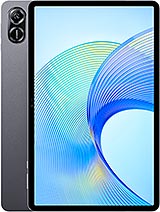Honor Pad X9 review

Magic OS with nice multi-tasking and Android 13
The Honor Pad X9 runs Android 13 out of the box and has full support for the Play Store and Google apps (worth mentioning in light of past relations between Honor and Huawei).
On top of the OS, there's an in-house layer of MagicOS (v7.1 in this case), where a lot of cool stuff is.

The multi-window functionality works well. You can launch apps into a split-screen view via a side menu, accessible by swiping from the right edge of the display. Tapping an app from here spawns a floating window of it, and you can now have two such windows open simultaneously, with every subsequently launched one minimizing one of the earlier ones to a separate icon on the side, opening a separate task switcher.
To initiate the split-screen view, you must long-press the app icon from the side dock and then drag it to another already open app. You can add any app you choose to this Multi-Window menu, and most seem to work and scale pretty effortlessly.
You can also have an app pair remain bundled together as one entry in the recent apps view, so you can easily close both of them or return to that particular side-by-side workflow.
Other than that, it's the familiar look and feel of Magic UI/EMUI. One of the other neat proprietary features is the 'large folder', all the more useful here than on the smartphones from the two brands - a large folder occupies as much space as four regular icons and holds up to 12 apps, which are immediately available. You don't need to expand the folder to launch an app.



Homescreen • Large folder • Settings
Performance and benchmarks
The Honor Pad X9 is powered by the Snapdragon 685, a lower midrange Qualcomm chip made on a 6nm process. In terms of CPU, you get four Cortex-A73 cores, clocked at up to 2.8 GHz and another four Cortex-A53 ones working at up to 1.9 GHz. It is paired with an Adreno 610 GPU. You also get 4GB of RAM, which is a bit low but okay for a budget tablet. The Pad X9 also offers 3GB of virtual memory for what that's worth.
The only storage tier is 128GB, and that's not expandable as there is no microSD slot.

Unfortunately, our Pad X9 review unit is locked down in some way that does not allow us to run or even install the majority of benchmarks. The only one we did manage to get working is 3DMark.
Regardless, we have seen the likes of the Snapdragon 685 before in smartphones, and it's not particularly impressive in terms of performance. The Snapdragon 685 is technically a bit better in the CPU department than the Snapdragon 680, as found inside the Honor Pad 8 and the Oppo Pad Air, but the Adreno 610 really fails to impress across all of these devices.
More powerful alternatives exist on the market in the budget segment, like the SD695-powered Realme Pad X or the Redmi Pad (Mediatek G99). That said, the tablet felt just fine in general use like web browsing, social media, and YouTube streaming.
Reader comments
- Wanda
- 23 Mar 2025
- XA3
I got one on contract and I'm absolutely in love with mine. My 2 kids got the Honor X7b cellphone
- Aaron
- 20 Feb 2025
- fm@
Why did you make it so you have to knock to use certain features like knocking and holding once does the drawn on screen thing and then knock knock takes a screenshot and with to knuckles knock twice to start recording like why it's so stupid ou...
- Mayar Asaad
- 27 Dec 2024
- GvH
I got one from my aunt, it was great. The camera was good and it charges quickly. I had several before but I didn't have it as good as the Honor Pad X9. Highly recommended.












